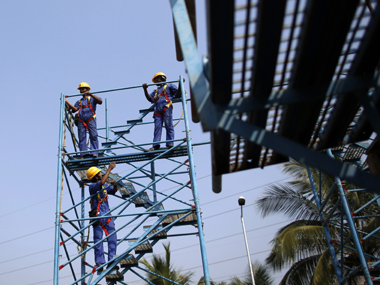By Shreehari Paliath Mumbai: India continued to be the world’s top recipient of remittance from its diaspora, gathering $69 billion in 2017 – nearly 1.5 times India’s defence budget for 2018-19 – an increase of 9.5 percent from the previous year, according to World Bank
data. Remittances to India from its diaspora increased 22 times to $69 billion in 2017 from $3 billion in 1991, but as a proportion to the gross domestic product (GDP) fell 1.2 percentage points to 2.8 percent in six years to 2017. Such remittances increased nine times worldwide to $613 billion during the same period. [caption id=“attachment_2376314” align=“alignleft” width=“380”] Representational image. Reuters[/caption] The countries that followed India in receiving remittances were China, the Philippines, Mexico, Nigeria and Egypt, according to the latest
migration report by the World Bank. Nearly $6.5 trillion will be sent in remittances to developing countries between 2015 and 2030, involving over a billion senders and receivers, according to this June 2014
note by the International Fund for Agricultural Development (IFAD), an international financial institution and United Nations agency. Close to half of the remittances will go to rural areas where poverty and hunger are the highest, it said. “Remittances are vital for millions of families, helping them to address their development goals,” Gilbert F Houngbo, president of IFAD, said in the release. The increase in remittances is likely to continue in 2018 due to strong economic conditions in advanced economies (particularly the United States) and an increase in oil prices that should have a positive impact on the Gulf Cooperation Council region (now known as Cooperation Council for the Arab States of the Gulf), including United Arab Emirates (UAE), Saudi Arabia, Bahrain, Kuwait, Oman and Qatar, the report said. Kerala topped the share of remittances (40 percent) with the number of workers sending money to the state increasing in five years to 2014, IndiaSpend
reported on 20 April, 2016, followed by Punjab (12.7 percent), Tamil Nadu (12.4 percent), Andhra Pradesh (7.7 percent) and Uttar Pradesh (5.4 percent) respectively. Remittances steady but contribution to GDP declines Remittances contributed to 2.8 percent of India’s GDP in 2017 based on projected figures, the World Bank report noted, the same as the previous
year. Over six years to 2017, the contribution to GDP fell 1.2 percentage points to 2.8 percent while the remittances averaged nearly $68 billion. In 1990-91, the contribution to GDP was 0.7 percent, which increased to 3.08 percent in 2005-06, Migration Policy Institute, a global think tank,
reported on 1 February, 2007. In 2011-12, remittances accounted for four percent of GDP, the highest level over the last six years, Hindustan Times
reported on 8 October, 2012. Migration of workers from India fell 39 percent between 2011-17 While remittances are expected to rise during 2018, workers migrating for work legally after completing ’emigration check required’ – required for travellers/workers who have not completed grade X in India – procedures in 2016 fell nearly 34 percent to 520,938 compared to 2015, according to the Migration 2018
report of the International Labour Organisation. The drop was due to the decline in crude oil prices and the resulting economic slowdown in the GCC countries. Overall, in seven years to 2017, the number of workers migrating fell 39 percent to 391,024.
There are more than 30 million Indians overseas with over nine million concentrated in the six Gulf nations. Indian workers going to Saudi Arabia declined 47 percent to 162,000 in 2016 from 2015, and workers going to the UAE fell 29 percent in the same period, the 2017 World Bank report showed. Inflows from the GCC made up 52 percent of remittances received in 2016, the ILO report said. In 2017, remittances sent by over 200 million migrants helped to sustain 800 million people across the world, the IFAD said. The author is an analyst with IndiaSpend.


)

)
)
)
)
)
)
)
)



